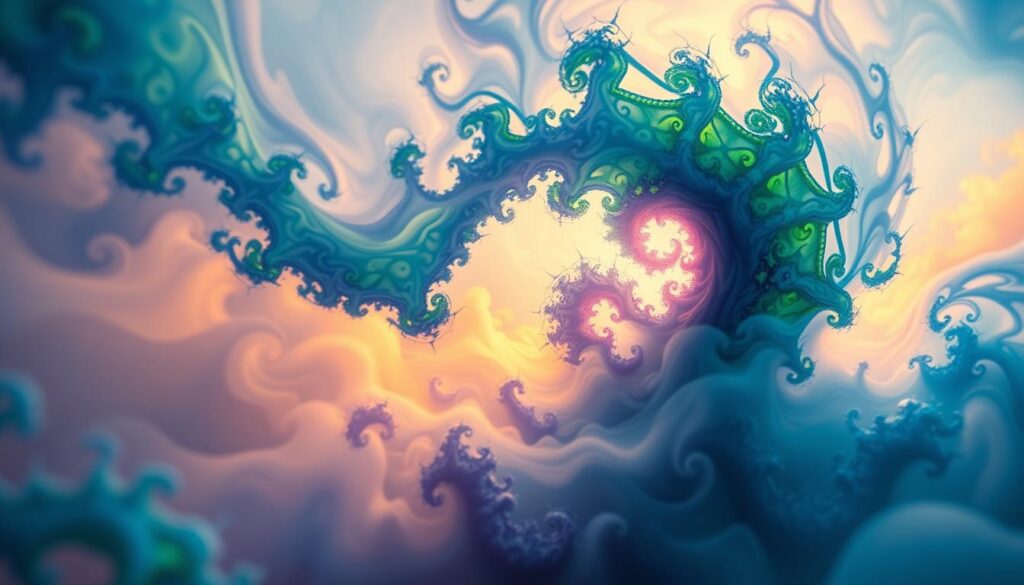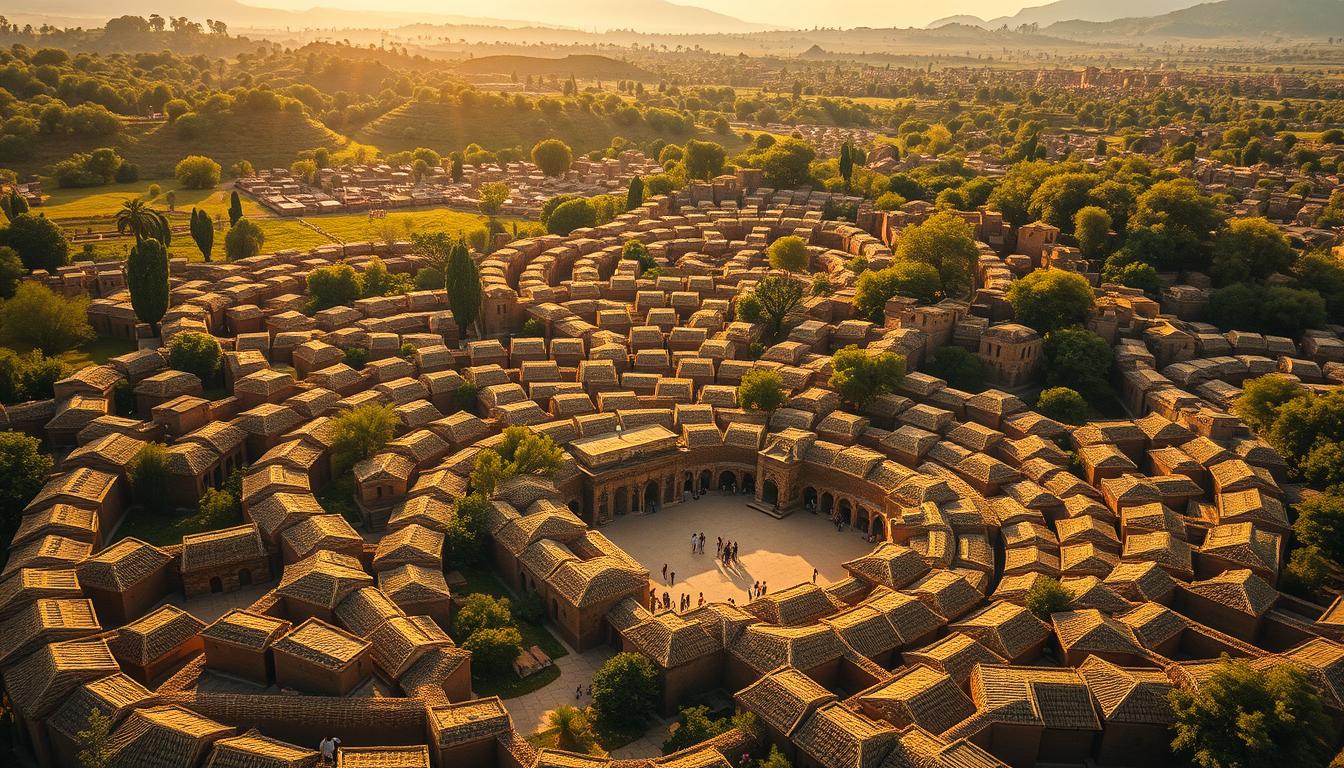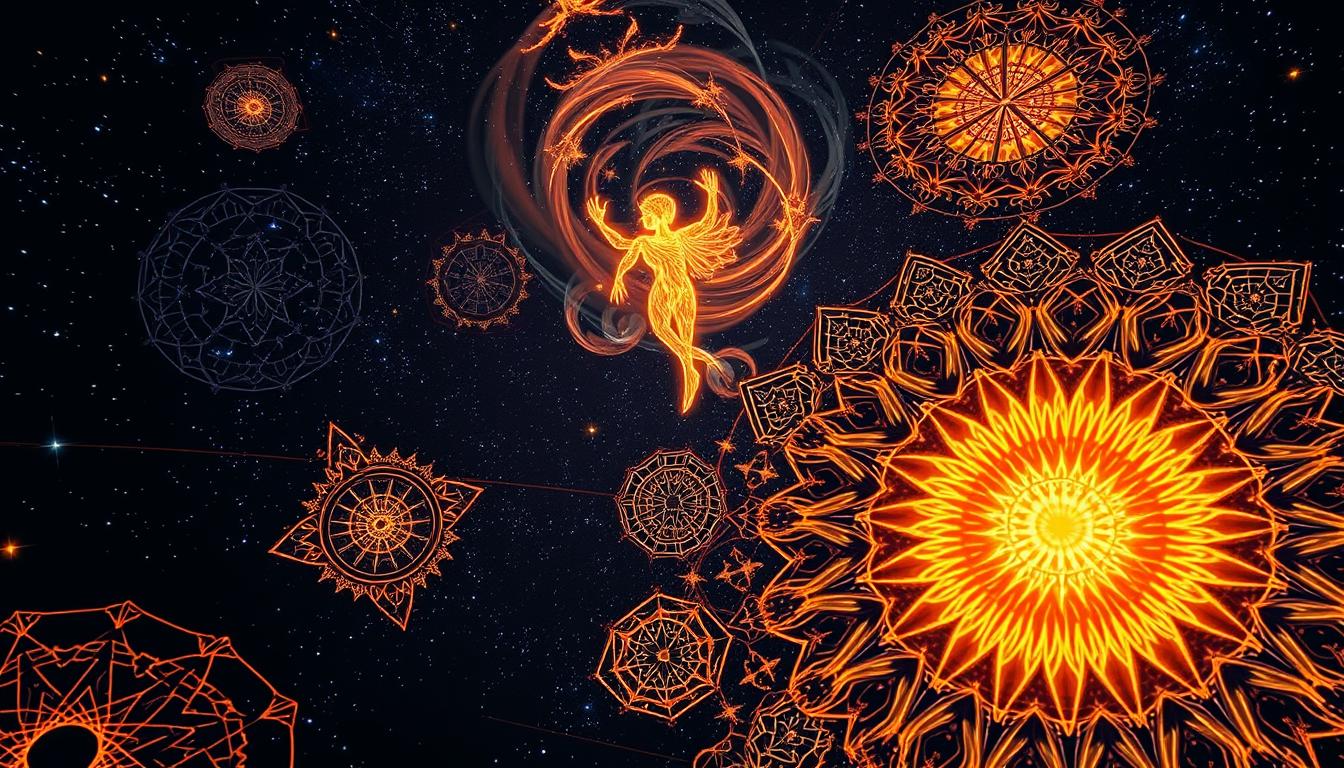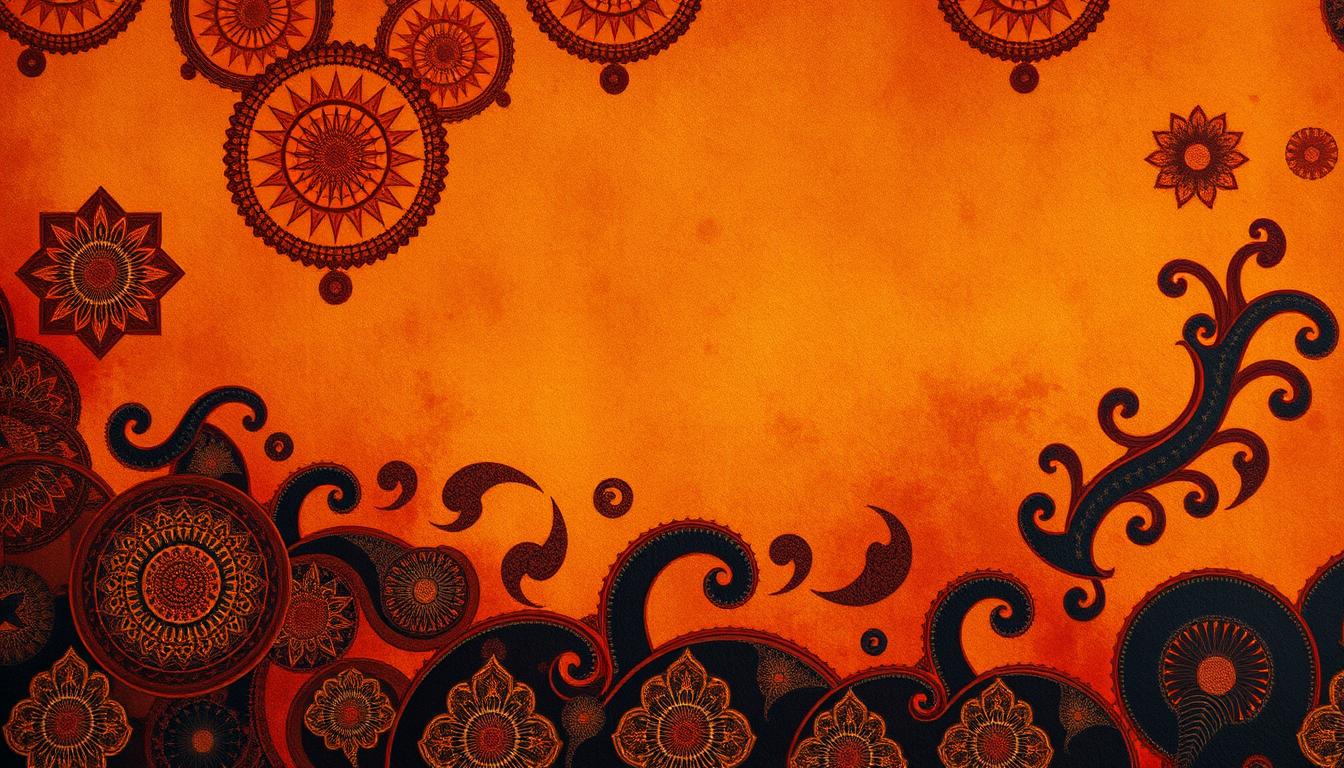Fractal imagery is key in indigenous rituals, showing a special way of looking at health. These patterns in nature show how deeply people and their surroundings are connected. In places like the Amazon, the variety of plant life is crucial for healing practices.
This includes the famous Ayahuasca ceremonies. These rituals improve physical, emotional, and spiritual well-being. They use fractal imagery to lead participants through a life-changing journey.
Introduction to Fractal Imagery and Healing
Fractal imagery, with its complex, repeating patterns, goes beyond simple math. It connects deeply with healing principles in various native cultures. These patterns show the beauty of the natural world and how everything in life is connected.
In many native rituals, fractal imagery links the physical and spiritual worlds. It appears in both art and nature. This highlights the bond between visuals in the wild and deep healing practices. Fractals in sacred shapes also point to their role in improving health and mental clarity.
Looking into fractal imagery shows its power in native healing methods. Through these patterns, people often find deep spiritual insights and emotional peace. It demonstrates how these designs are knit into our human experiences.

Understanding Indigenous Rituals and Their Purposes
Indigenous rituals are vital to many cultures and serve many important roles. They focus on healing, using age-old methods to bring back balance and health. These rituals mean more than just getting better physically. They connect people spiritually and bring communities closer together.
The shaman or healer plays a key role in these rituals. They use their wisdom to lead others on healing journeys. This helps individuals and their communities grow. These rituals change over time, adapting to new cultural and environmental conditions.
These practices also bring people together, creating a strong sense of unity. By looking through an anthropological lens, we see the value of these rituals. They heal, preserve traditions, and strengthen community bonds.
Connection between Fractals and Nature in Indigenous Culture
Indigenous cultures have a deep connection with nature, where fractals are key in their beliefs and rituals. These complex patterns, seen in things like tree branches or shells, repeat at different scales. They greatly influence indigenous art and practices.
Many indigenous groups see fractals in nature as a sign of how everything is connected. They believe everything is part of a larger whole. This idea encourages people to live in harmony with their surroundings.
Indigenous peoples often use fractal designs in their art, reflecting their environment. This is shown through artifacts and practices, especially in areas like the Amazon. Here, communities use fractals in ceremonies, mixing art with spirituality and nature.
Nature’s patterns inspire and guide these cultures. Understanding fractals shows how they maintain their knowledge, combining art with environmental awareness. This links their spiritual beliefs closely with nature, shaping their cultural identity.
Healing Properties of Fractal Imagery in Indigenous Rituals
Fractal imagery helps a lot in indigenous rituals’ healing processes. These patterns do more than look nice; they aid in mental and emotional health. In ceremonies like those that use Ayahuasca, people see fractal images. This can change their state of mind.
These experiences help folks look deep inside themselves. By doing so, they find healing through self-reflection and learning new things about their minds.
In these ancient practices, connecting with nature and art is key. They use fractal patterns to make the spiritual journey better. These colorful designs make people respond in ways that help them deal with hard emotions and past traumas. It shows how deeply fractal imagery can affect wellbeing, making a space where art meets healing in these old traditions.
Psychological and Emotional Aspects of Fractal Imagery
Looking at visual patterns can deeply affect our minds and emotions. Fractal experiences help with relaxation and make us feel good. When people see these complex designs, they feel calmer and more emotionally stable.
The Healing Power of Visual Patterns
Studies show that fractal imagery has many psychological benefits. These patterns can calm the mind, making us feel less anxious and more at peace. They match our love for order, helping us relax and heal emotionally.
Emotional Resonance in Fractal Experiences
Watching fractal imagery during rituals can lead to strong feelings. People often find themselves thinking deeply, which helps them understand themselves better. These experiences can bring up hidden memories and feelings.
Studies say that this kind of visual stimulation works on the brain areas related to emotions and seeing. This shows how important fractals can be in helping us feel better.
Traditional Healing Practices and Fractals
Many indigenous cultures use traditional healing practices. These often include plant medicine. The connection between fractals and healing properties of psychedelics is central. Ayahuasca plays a key role, blending the visual and spiritual experiences with the natural substance’s effects.
Role of Plants and Psychedelics in Indigenous Rituals
Psychedelic plants are crucial in traditional healing. Indigenous shamans use various plants for their unique healing properties. These plants lead to altered states of consciousness, revealing fractal patterns. This visual experience aids in healing emotional pain.
Fractal Patterns in Ayahuasca Ceremonies
Ayahuasca ceremonies show how traditional healing interacts with fractals. Participants drinking the brew report seeing intricate fractal patterns. These patterns are more than visual wonders; they help in the healing journey. They allow participants to dive deep into self-exploration, gaining insights and emotional relief.
The Scientific Perspective on Fractal Healing
Recent studies have started to look into how fractal healing works, especially in neuroscience. Scientists are studying the effects of fractal images on our mental well-being and brain functions. They’re finding out how these effects are similar to those in ancient healing rituals.
Neuroscience and Fractal Imagery
Neuroscience is uncovering interesting facts about fractals and our brains. It looks into how our brain pathways light up when we see fractal patterns. It turns out, these fractals can help us feel calm, which is good for our emotional health. This helps us understand why fractals are used for healing in many traditions.
Effects of Geometric Patterns on the Brain
The way geometric patterns, like fractals, affect our brains is quite fascinating. Looking at these patterns can make us more focused, less anxious, and happier. This is part of the reason fractals are used in healing across different cultures. By studying this, scientists can connect old healing methods with new scientific discoveries.
Aesthetic Representation of Fractal Imagery in Indigenous Art
Indigenous art shares cultural stories in a powerful way. It often uses fractal imagery to express deep meanings. This use of fractals is not just for show. It represents spiritual beliefs, traditional knowledge, and practices of healing. Such pieces of art show how everything in nature is connected.
Many artworks have patterns that repeat, similar to plants, rivers, and humans. These fractal patterns hold the stories and teachings of spirituality. Colors and shapes make the art even more complex. They invite people to look deeper into the meanings of each piece.
Notable artists blend fractal imagery with modern ideas. Their art does more than look beautiful. It carries forward the traditions and stories of their people. This art shows the spirit of life and gives a unique view on what it means to exist.
Experiencing Fractals through Music and Sound in Rituals
Using music and sound in native rituals opens a new way to see fractal visuals. These sounds make the experience of visual fractals better and help reach different states of mind. Instruments like drums and flutes make sounds that mix well with the complex shapes of fractals. This creates a link between what we hear and what we see.
The Relationship between Sound and Visual Fractals
In rituals, music makes the fractal experience stronger. The beats and tunes bring us closer to nature. Sounds like chants and drumming match the visual patterns. This mix makes the experience deep and healing. Many native traditions use this connection. It lets people reach deep into their minds and feelings.
- Native instruments like the didgeridoo and flutes create sounds that match fractal shapes.
- These sounds can make us feel calm and deepen our visual experience.
- Chanting together in rituals makes everyone feel connected through sound and visuals.
Looking into how native traditions use sound and music shows its power. It doesn’t just support fractal experiences but lifts them up. Through sound, the change that fractals bring becomes clear. It shows how sound, feeling, and healing are linked in rituals.
The Contribution of Visionary Artists to Fractal Imagery
Visionary artists are key in bringing fractal imagery to life. They show how art, spirituality, and healing are connected. They often use ideas from old traditions, focusing on nature and the universe. Pablo Amaringo is famous for his art that mixes nature with psychedelic and fractal patterns. His art connects ancient wisdom to modern fractal ideas.
Pablo Amaringo and Other Influential Artists
Pablo Amaringo’s art is very important. It shows the deep relationship between humans and their environment. He mixes reality with the universe in his fractal images. This lets people think about their own spirituality and Earth connection. Other artists also use fractal elements in their art.
- Alex Grey, known for his detailed works on consciousness and connection.
- Robert Venosa, whose paintings show beautiful landscapes with fractal patterns.
- Ken Adams, who uses digital art and fractals to create emotional art.
Together, these artists help people appreciate fractals more. They add to discussions on healing and spiritual journeys from old traditions. Their art encourages a new generation to see the beauty in the mix of art and nature.
Preservation of Indigenous Knowledge and Fractal Traditions
Keeping indigenous knowledge alive is crucial as modern challenges threaten unique traditions. Healing practices, particularly those involving fractal imagery, face threats from globalization and resource exploitation. It’s critical to raise awareness and act to protect these precious traditions.
Challenges Facing Indigenous Cultures Today
Indigenous cultures face several challenges, including:
- Loss of language and traditional practices
- Environmental degradation impacting sacred lands
- Commercialization of cultural artifacts
- Continued marginalization in political and social spheres
These challenges make it hard to pass down knowledge. This is especially true for healing traditions rooted in fractal imagery. Such knowledge is key to community identity and cultural survival.
The Need for Global Stewardship
We all have a role in protecting indigenous cultures and their heritage. Ways to help include:
- Supporting indigenous-led conservation projects
- Advocating for policies that respect indigenous rights
- Promoting cultural exchange and education for awareness
By committing to global stewardship, we can help preserve indigenous knowledge. This ensures future generations can also benefit from these ancient healing traditions.
Conclusion
This study of fractal imagery shows its deep *healing properties* in *indigenous rituals*. Fractals link to nature and the traditions of indigenous peoples. This helps us understand their practices better. It also shows how important these ancient traditions are today. As we see how fractals help with emotional and spiritual healing, we learn a lot from indigenous knowledge.
We must value and keep *indigenous healing* practices alive. Looking forward, adding these practices to modern wellness could lead to better health care. Exploring fractal imagery has big effects on *health* and *well-being*. It benefits indigenous groups and others worldwide who want to learn from these traditions.



